The ups and downs of fate "Uralbomber" Junkers
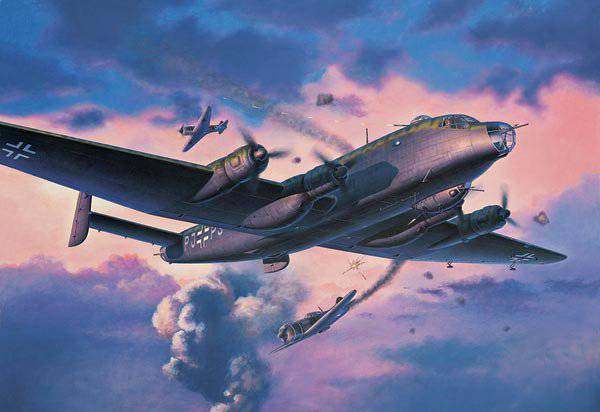
In the summer of 1935, Dornier and Junkers received from Walter Wefer (the first head of the Air Force headquarters) specifications for a long-range heavy bomber. According to the assignment, the aircraft was supposed to be a free-flying monoplane with retractable landing gear, which should be able to deliver 2,5 tons of bombs to targets in the Urals or in Scotland. The project received the sonorous name "Uralbomber." About the work of the company Dornier, we have already told in the article "Uralbomber." The first four-engine "strategist" of the Third Reich ".
On Junkers, Ernst Zindel led the work on this topic, making extensive use of the experience gained in creating Ju 86. Junkers offered its four-engined Ju 89 bomber to the Luftwaffe, the first prototype flight of which took place in December 1936. This second prototype, assembled at the beginning of 1937, was used for flight tests and did not have armament, while the third prototype already had was a full bomber. He had defensive weapons and was equipped to place 1600 kg of bombs in the extensive bomb compartments in the middle part of the fuselage. The fuselage itself was a duralumin monocoque of square section, the set of which consisted of frames, stringers and smooth metal plating. The wing consisted of five sections. The center section was carried out in one piece with the fuselage and had five spars. The inner section of the console had five main and two auxiliary spars, and the outer four main and three auxiliary. The flaps were of the type of "double wing Junkers" and consisted of two sections.
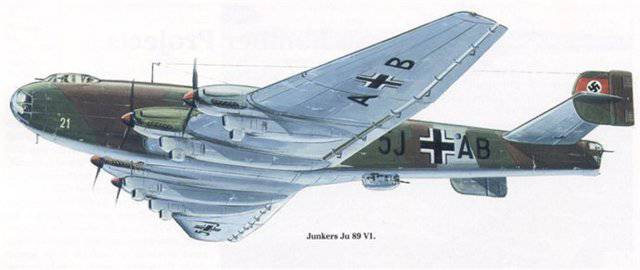
The aircraft had all-metal spaced tail. The stabilizer, adjustable in flight, had a span of 11,29 m, with vertical tail mounted at its ends. Handlebars of the suspended type, as well as ailerons. The tricycle wheeled chassis was retractable, with the main landing gear retracting back into the fairings of medium-sized engines, and the tail wheel retracting into the fuselage.
The power plant consisted of either four Junkers Jumo-211A engines, or four Daimler-Benz DB-600A; 12-cylinder liquid cooling power 960 HP each. For an aircraft with a flight weight of almost 28, this engine power was clearly insufficient. It is therefore not surprising that the maximum flight speed was only 365 km / h, and cruising speed was 312 km / h. And although the company "Junkers" fulfilled the basic requirement relating to the flight range, she was asked to take measures to increase the speed of the aircraft. A crew of nine was envisaged: two pilots, a radio operator, a flight engineer scorer, and five gunners. The defensive armament consisted of one machine gun in the nose of the fuselage, the same machine gun in the tail set and guns in the upper and lower hydraulically controlled twin towers. In the bomb bay on a vertical hanger, 16 * 100 kg or 32 * 50 kg could be placed.
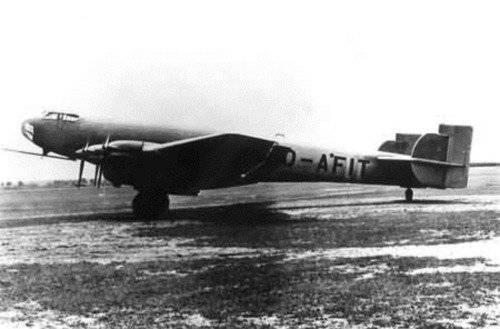
The first two prototype aircraft, the Ju 89-V1 and V2, were already in a high degree of readiness when Lieutenant General Wefer died in a plane crash on June 3, 1936. The premature death of the main supporter of heavy bombers led to the advent of Albert Kesselring, who opposed the construction of a strategic aviation at this stage of the development of the Luftwaffe, which was detrimental to tactical aviation, this was the main reason for the termination of work on the Ju 89.
The initial stage of the Second World War seemed to confirm the correctness of Vefer's opponents: the composition of the Luftwaffe fleet turned out to be almost optimally adapted to the maintenance of the “blitzkrieg”, and the German aircraft at this stage achieved great success. But after the war took the form of a protracted confrontation, the absence of long-range bombers in the Luftwaffe began to be felt. Soviet enterprises located in the same Urals and in Western Siberia relatively quietly produced in enormous quantities. weapon, military equipment and ammunition, but Germany could not counteract this. But, we will not go into this article on the topic of alternative stories.
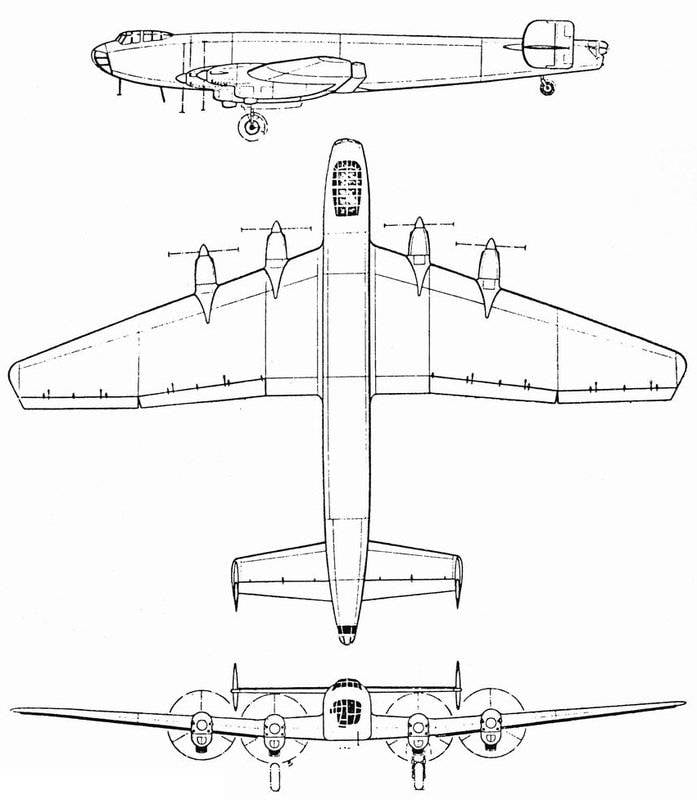
Meanwhile, the insistent demands of the Technical Department, represented by General Kurt Pflugbeil’s Bomber Aviation Inspector, made it possible to continue work on experimental machines. At the same time, the entire Uralbomber program was revised. Tsindel had doubts about the possibility of continuing the program, as the revision of the requirements resulted in 1936 g in November (just a few weeks before the first flight of the Ju 89-V1) to the emergence of new specifications for the so-called bomber A. As a result, the chief designer made a request to use the Ju nodes 89-V3 for the manufacture of commercial transport aircraft. Ju 89-V1 flew in December 1936 g. It was equipped with four Jumo-211A engines with power 1075 hp at 2300 rpm and Junkers-Hamilton screws. During the tests revealed some exchange rate instability. Therefore, plumage washers increased in size. At the same time, additional air intakes were installed under the external engines.
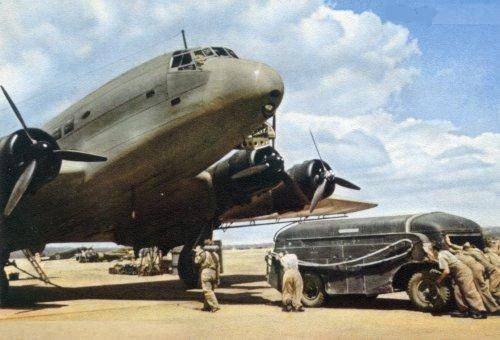
Ju 89-V2 began testing at the beginning of 1937 g. He was distinguished by the installation of four DB-600A engines with an output of 960 hp with 2350 revs and VDM screws. By this time, work had already begun on the conversion of the third Ju 89-V3 into the transport Ju.90. V3 was supposed to receive mock-ups of twin Mauser towers, and they were already mounted on the plane when RLM received permission to use wings, engines, landing gear and tail for the release of Ju 90-V1. The flight tests of the Ju 89-V1 and V2 continued until the official termination of the 29 program on April 1937. Both were used for tests as part of work on a commercial aircraft. In the summer of 1938 g on Ju 89-V1, two records were set for lifting loads to a height (5000 kg on 9318 m and 10 000 kg on 7246 m), although it was officially stated that the records were set on Ju 90-V1. Later, the prototypes were converted into transport aircraft and were used as such during the landing in Norway as part of KG.zbV105.
The aircraft of the project Junkers Ju 90 has become a kind of "by-product" of the creation program, which has not been put into serial production by the four-engined heavy bomber Ju 89. E. Tsindel, began, on an initiative basis, the development of a passenger version as early as April of 1936. And in January of 1937, the work was authorized by the Reich Minister of Aviation, and the project was designated Ju 90.
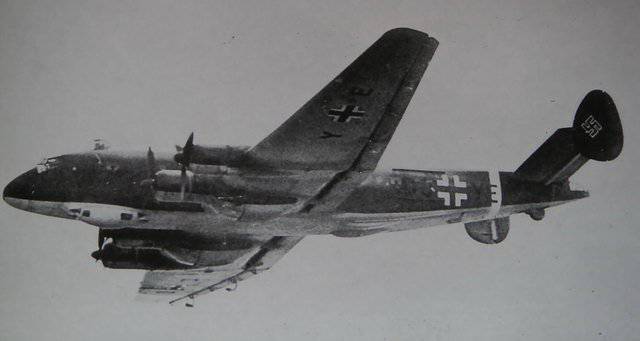
In this case, the condition was set to abandon the Jumo 89 or DB 211 motors provided for the Ju 600, which were fully reserved for combat aircraft, in favor of other types of engines. The new aircraft inherited from Uralbomber the general scheme of an all-metal low-wing with two-tail and retractable landing gear, but received a new fuselage with a passenger cabin designed for 40 people. The first prototype of the Ju 90V1 had to be equipped with DB 600С engines (1100 hp) - at the time of the decision of the Reich ministry of aviation to prohibit the use of such motors, its construction went too far to make changes. The screws were three-bladed, metal, variable in flight pitch. With such a propelled engine group, the aircraft developed a maximum speed of 410 km / h. (At that time, the German Me-109 fighter flew with a maximum speed of 468 km / h, and the Soviet 16 5 type was 454 km / h.) The fuel supply was enough for a flight over the 3000 km range. The fuel tanks located in the wing were equipped with devices for the rapid discharge of fuel in the event of an emergency landing or fire.
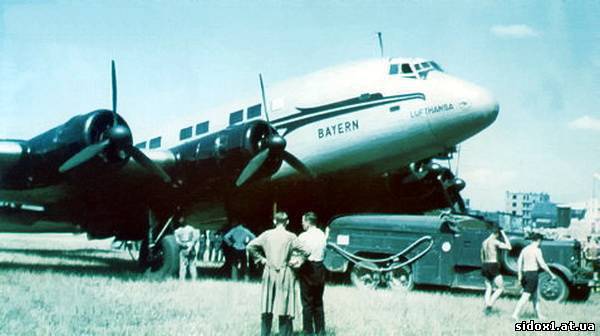
A total of 18 built the Junkers Ju 90 - 8 prototypes and 10 serial passenger aircraft of the following modifications:
Ju 90А-1 - engines BMW 132Н-1 (HP 830). Crew - 4 people. Capacity - 38-40 people. 8 aircraft were ordered for Lufthansa, but only 7 was delivered - the last car in April 1940 entered the Luftwaffe.
Ju 90Z-3 - Pratt & Whitney "Twin Wasp" 14-cylinder air-cooled air engines. The 1200 aircraft was ordered for the South African airline, but after the start of World War II, the vehicles still in construction were confiscated by the Luftwaffe.
Junkers Ju 90 was a very good example of the creation of a passenger plane based on the design of a bomber. If it were not for the war, cars of this type, for sure, would occupy a prominent place on distant passenger lines. But in the end, the few released Ju 90 had to serve as military vehicles and “smell the powder”.
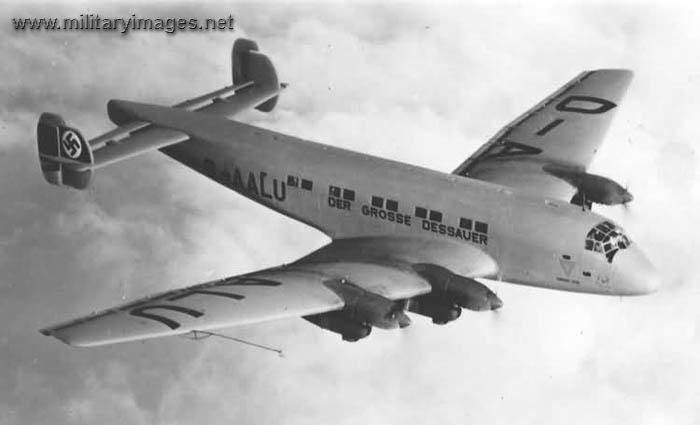
Operation Wezarebung was his combat debut. It was attended by 5 mobilized aircraft of this type, consolidated in the detachment 4./KGr.zbV 107. Machines threw personnel and cargo to Norway. In May, 1941, three aircraft taken from Lufthansa (along with civilian crews) provided transportation to Iraq to support the Rashid Ali insurgency. In addition, two Ju 90 were used as tugboats of Messerschmitt Me 321 heavy landing gliders.
In February-May 1942, all Ju 90s in service (both military and still remaining at Lufthansa) were used to supply the surrounded Wehrmacht formations under Demyansk. In November 1942, they participated in the transfer of units of the Wehrmacht to Tunisia.
At the beginning of January, the 1943 7 of the Ju 90 aircraft became part of the LTS 290 squadron (also known as the “Viermotorige-Transportstaffel“ detachment of four-engine transport aircraft ”). In the same month, the detachment was transferred to the Stalingrad area to supply Paulus with the surrounded army. From March to July, 1943. LTS 290 operated on the Mediterranean theater of operations, based in Grosseto (Italy), then relocated to Germany, flying in the interests of the Wehrmacht high command. In December 1943, this squad was renamed LTS 5. In the spring of 1944, his Ju 90 (three vehicles of this type remained in service) provided for the evacuation of German troops from the Crimea. In August, 1944 aircraft Ju 90 transferred to the squad 14./TG 4, 1944 in the fall working on the lines of communication with the occupied Greece. By the end of the war, there were still two Ju 90s in the Luftwaffe, which were scrapped after the defeat of Germany.
Ju-90 was a very good passenger aircraft for its time, but in the conditions of the outbreak of the Second World War, the Luftwaffe, the main consumer of aircraft in Germany, needed a military transport aircraft. Therefore, the company "Junkers" once again redesigned the aircraft. His seventh prototype, the Ju-90V-7, which made its first flight at the beginning of 1941, was equipped with a lowered ventral ramp, which significantly accelerated the loading and unloading of soldiers and military goods, and the engines were replaced by BMW 801A with HP 1600 power. This version of the aircraft was also designated as Ju-90S, later it was given the designation Ju-290V-l, and it became the prototype for the first purely military modification of Ju-290A.
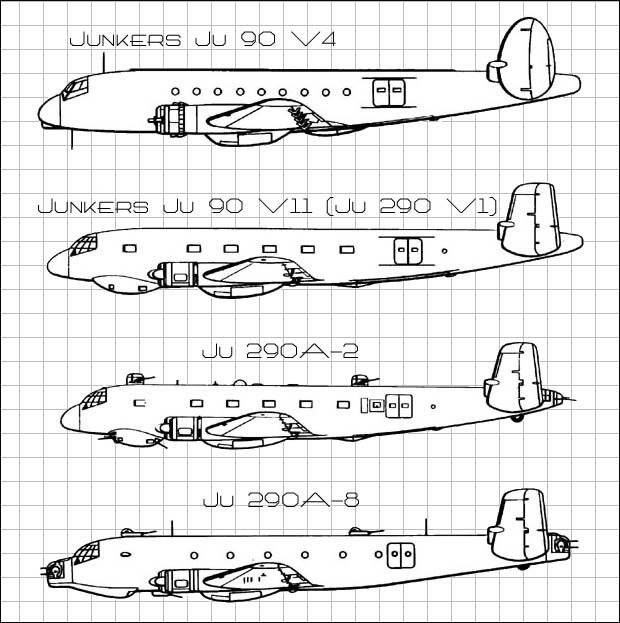
The total length of the fuselage of the new aircraft has increased from 26,5 to 28,7 m. This has improved the stability of the machine on the course and restore centering, broken due to the installation of more powerful and heavy engines. At the same time, the center wing section was reinforced. By this time, Ju 290 was planned to be used as a transport aircraft and a long-range maritime reconnaissance aircraft. The next prototype aircraft received an elongated fuselage modeled on the V7 and a small lower gondola on the left under the fuselage. It housed the MG-151 / 20 cannon, firing forward, and the MG-131 machine gun back. A hydraulically controlled turret with a MG-151 / 20 gun was installed behind the cab, and the third MG-151 / 20 was in the tail cockpit arrow. The installation of two MG-131 machine guns was envisaged in the side windows.

Preparations for the series production of the Ju 290A began in Bernburg in the first months of 1942. The serial production was approximately 60-70 machines. For two Ju 290A-0, the military transport planes Ju 290A-1 were built, and the designations from Ju 290A-2 to Ju 290A-9 were given to different variants of reconnaissance aircraft. The most interesting serial modification was the carrier of the guided weapon, the Ju 290A-7, which flew in the spring of 1944. It was distinguished by a bulbous glazing of the nose section with an increased composition of defensive armament up to seven 20 mm guns and one 13 mm machine gun. Under the wing, two ETS holders and one more under the fuselage were mounted. On each, you could hang a 1000 kg bomb, or Henschel Ns.294 and FX-1400 Fritz-X guided missiles. The maximum take-off weight increased to 46 000 kg, the maximum speed at an altitude of 5800 m was 435 km / h, and the flight range was 5800 km.
An exception to the scout series was the Ju 290A-6 passenger transport aircraft, designed for 50 passengers and transferred to I / KG.200. This unit was responsible for the transportation of escaping Nazi criminals, and who brought Ju 290A-6 to Barcelona in this way remained a mystery. However, the aircraft remained in Spain, and in May 1950 was acquired from the Allied Commission for the Distribution of Property of the Former Enemy. After repairing and replacing the protected tanks from the "Buna" with metal, Ju 290A-6 entered Escuelo Superior de Vielo in Salamanza. During the exercises, he interacted with fleet, and was also used for transportation. In the mid-50s, the plane was slightly damaged in the accident, but due to the lack of spare parts it had to be written off.
At the end of 1943 g, work began on a new modification of the basic design Ju 290B-1, which finally broke up with the cargo ramp and was intended solely for the role of a maritime reconnaissance and long-range altitude bomber. Those. the circle was closed, and the car leading its pedigree from Ju 89, having passed the way through transport and passenger options, again became a strategic bomber. The entire bomb load was placed on the outer holders. The design of the Ju 290B-1 was strengthened, and the cabins became airtight. Sealed Borzig turrets with four MG-131 machine guns in each were installed in the nose and tail, on the fuselage there were two airtight towers with a pair of MG-151 / 20 guns in each, and a remotely controlled MG-151 / 20 turret was located under the fuselage. For this tower was equipped with a sighting post on the site of the lower gondola. The flight deck was supposed to be sealed; experiments with the pressurized cabins were carried out in Prague. The crew was to consist of eight people. Defensive weapons assumed patterned A-7. Experienced Ju 290B-1 flew in the summer of 1944 r without gerkabin, with wooden mock-ups of towers.
Even before the completion of the work with Ju 290B-1, it was decided to launch a new version instead of him in the series, Ju 290B-2. He was distinguished by the lack of sealing of the towers and the cockpit, the installation of the side cannons MG-151, the replacement of the tail tower MG-131V with a rifle installation under the two guns MG-151 / 20 modeled on А-8. Although work on the pre-series Ju 290B-2 began in Bernburg, the situation with the supply of strategic raw materials forced us to stop preparing for the serial production of the Ju 290.
It also led to the cessation of work on several more projects, including the minesweeper Ju 290-MS with magnetic winding and reduced defensive weapons; long-range reconnaissance and transporter Ju 290C; Ju 290D and E. Ju 290C bombers, like the Ju 290B-2, were to receive BMW-801E engines and a new cargo ramp with a built-in turret with two MG-151 / 20. The Ju 290D was generally similar to the Ju 290C, with the exception of the installation of the Hs.293 missile system instead of the fuselage tanks of the guidance system. Ju 290E received an internal suspension 4 * 2500 kg bombs or 40 * 250 kg. It was planned that the first Ju 290E series will be equipped with BMW-801E engines, and the main production model will receive Jumo-222А-3 / B-3, the maximum take-off weight will be 60 500 kg.
And the latest development of the series of these machines was the aircraft Ju 390 - an enlarged version of the Ju 290 with a wingspan of 55,35 and six BMW 801D engines rated at 1268 kW (1700 hp). Two prototypes of the aircraft were built and tested in the 1943 year. Having started from France, Ju 390 reached the American territory just north of New York and, without landing, returned back. However, the aircraft did not receive further development.
Fighting career Ju 290 was not very rich. The first combat use of Ju 290А is the delivery of cargo to the blocked 1942 / 43 in Stalingrad in winter. Since March 1943. they began to be used to transport goods to Tunisia. Since November, 1943 g. Ju 290 began to carry out patrols in the North Atlantic, targeting submarines to Allied ships. Gradually, they displaced the FW 200C in this quality, leaving them only percussion functions. Junkers' scout proved to be very good in control and was highly appreciated by the crews. The scouts did not suffer a single loss due to flight incidents, all losses were combat. The HoGentville locator FuG 200 allowed to detect a convoy from 500 m for 80 km, and from 1000 m for 100 km. The plane gave the direction to the convoy for the submarines for several hours until the next plane took off from the base. Several vehicles were transferred to I / KG.200, where they were involved in slinging agents as part of the 3 squadron, for which a landing hatch was equipped in the fuselage.
In addition to the Ju 290A-6, another aircraft was operated after the war. This was the partially disassembled second pre-series Ju 290A-8, discovered after the release of the Ruzin airfield near Prague. Along with him were the nodes from Ju 290B-2. Parts of the aircraft were transported to the plant Letov, engines and instruments were found in the stocks of the former Luftwaffe, after which the assembly of the Ju 290A-8 began. Since no screws for Ju 290 were found, they decided to install screws from Fw 190A, which, despite the smaller diameter, were quite suitable. The lower gondola and turrets were removed, the front and rear rifle installations closed. The plane flew in August 1946 r already as the L-290 Eagle. It was offered to Czechoslovak Airlines as an 48-local passenger liner, but didn’t evoke any interest. Then for several more years the plane was in Letnani near Prague, they tried to sell it to Israel, but in the end it went to scrap for 1956 g.
Thus, fate was pleased to dispose of so that none of the aircraft Junkers did not become the "Uralbomber."
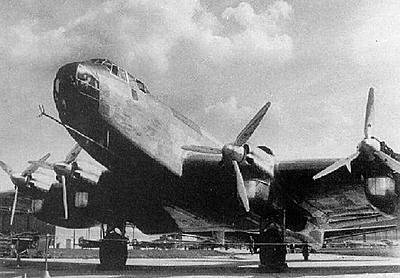
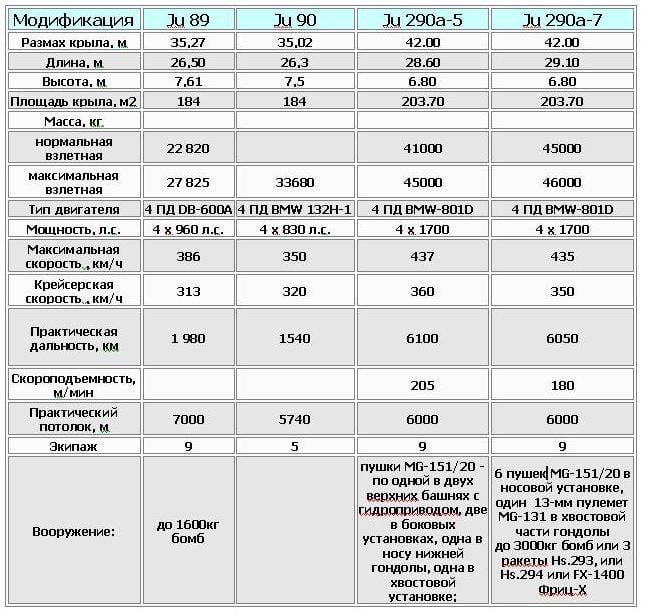
Information sources:
Green William. Wings of the Luftwaffe (warplanes of the Third Reich).
Kozyrev Vyacheslav, Kozyrev Mikhail. America-Bobmer // Wings of the Motherland.
Sea planes of deck and coastal bases of the Second World War // Model-designer.
World Aviation 163.
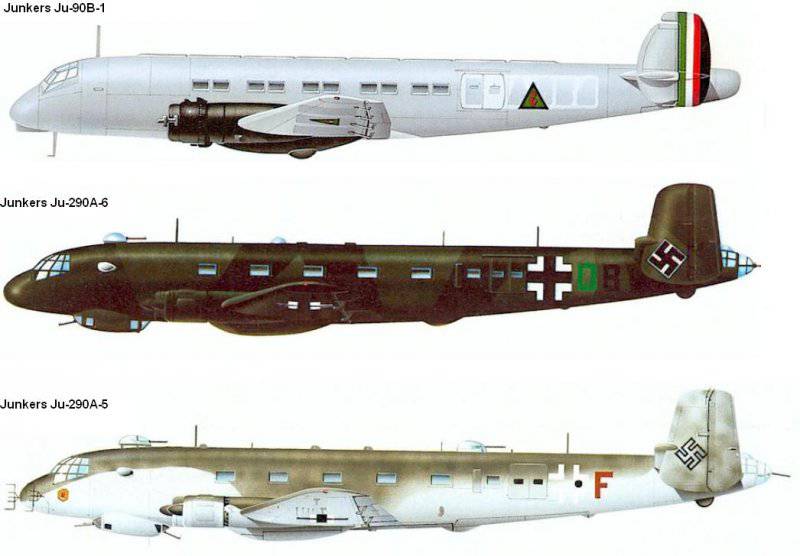

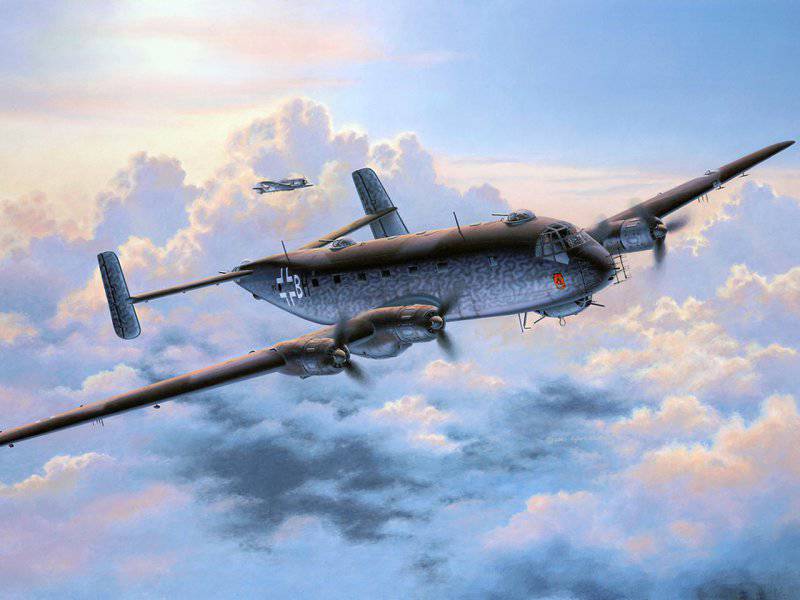
Information